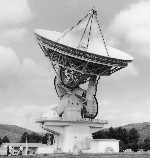
Telescope
| Radio Telescopes |
Most of what we know about the Universe comes from information that has been carried to us by light. But we have seen that visible light is only a small part of the electromagnetic spectrum. In recent years the remainder of the electromagnetic spectrum has revealed extensive information about our Universe.
 |
| NRAO 140 Foot Telescope |
Radio telescopes are used for many purposes, but let us describe two here explicitly: the mapping of neutral hydrogen concentrations using the 21 "spin-flip" transition line of emission from hydrogen, and the use of multiple radio telescopes operated as if they were a single telescope of very high resolution.
Radio observations can also see objects much fainter at large distances because radio waves are not scattered by the large amount of dust particles in the Galactic gas.
In addition, there are large numbers of sources that are very luminous in radio waves but less so in visible. Thus we gain more information on these sources.
Radio telescopes have much worse angular resolution (cannot see as much detail) than optical telescopes. For example the best optical telescopes have 0.5 arc seconds resolution from the ground and have 10meter mirrors. A radio telescope with 30 meter collecting plate has 0.5 degree resolution. (That is the diameter of the moon).
But it is possible to use more than one radio telescope at separated locations and have them function to some degree as if they were a single telescope. Such a device is called an interferometer, and the resolution of the corresponding device is dictated by the distance between the two telescopes, which can be enormous compared with the size of the individual telescopes. This larger effective size is termed the synthesized aperture of the system. Here is an illustration of a set of telescopes operated as a simple interferometer.